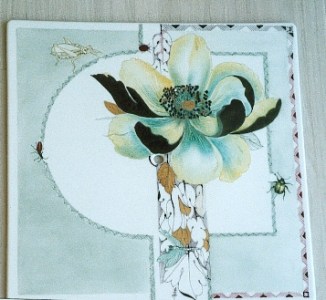| First you have to decide what porcelain you want to paint. Then choose
the composition. Let's say you want a big sun behind the flowers as I did
in the magnolia, or the porcelain is a big porcelain tile for a clock as
for the peony.
Materials needed:
Ordinary paint dry, mix it when needed.
Waterbased painting media, I use RCP painting medias. It comes in painting medium and a thinner. The thinner is good for padding, banding and penwork. The thicker painting medium is useful for Flora Danica technique, wet in wet, and for brushstrokes.
A good thin hard pen for penwork.
A good sponge for padding, I use Carlos Spina's sponges.
Scotch blue flexible tape 2 mm. (Note from
Marci: auto striping tape would also work. It can be found at most auto
parts stores)
Chipping powder and a plastic bag to use
when you take off the glaze with a little sharp knife (do not use your
palette knife, please.) (Note from Marci: a good incising powder is made
by Jean Beebe ...beebe@wave.net...or
you can also use incising beads and flux.)
Base for gold, matt.
Lustres if you like (e.g. mother of pearl
green, pink or yellow. These lustres have to be applied in small quick
strokes, in different directions, that will give the iridescent look,
if you work too much in MOP it will turn bluish gray.... the same if you
pad it with a sponge to make it even.)
Liquid bright gold. Brush for the gold
Put the design together, and trace it on tracing paper. Transfer the
design to the china with graphite paper. Then decide what techniques you
want to use to achieve what you want: The sun behind the magnolia: chipping
off the glaze. Gold on the backside of turning leaves: Base for gold,
scratched in a pattern when dry. Apply it very thin, the gold turns easily
dark if the gold base is too thick. (Do remember that I use waterbased
painting medias, (I am allergic to turp. After 45 years of painting) they
do not dry up as oil based oils and therefore they are more easy to make
a pattern in with a toothpick or a wipe-out tool, the pattern are much
easier to make when the paint is dry, because you can blow away the small
bits of paint, and the colour will not collect up in thick wet lines.)
Penwork in lines or dots. Mix your paint with waterbased RCP thinner,
and add a drop of water, and it should be possible to make very fine penwork.
I use a fine steel pen, hard, I think Mr. and Mrs. has the pens I use.
When the paint is like a thick drop on the pen nib do add a bit more water.
Washes and painting with a sponge. Painting with a brush, I use a big
no# 5 pointed brush, and always synthetic brushes when painting with water
base they keep the spring, hairbrushes drop dead! Negative lines made
with the wipe out tool.
|
